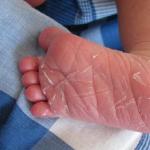Foot wraps: educational program from the amateur estimata. How to wrap foot wraps correctly: methods Wrapping the left leg
Footcloth - a piece of fabric for wrapping legs, underwear, a rectangular (approximately 35 cm by 90 cm) piece of warm and strong fabric, which was used in the old days instead of a sock. Foot wraps were worn with bast shoes or boots. Currently, foot wraps are widely used in the Russian army.
In order for the footcloth not to unwind when walking and running, it must be wrapped in a special way (tightly) around the leg. This should be done from the toe of the foot and always “outward” and not “inward”, so that when walking it does not get lost and does not rub the foot. The foot in the footcloth is actually wrapped in two layers of fabric, which retains heat better, and if it gets into water for a short time, only the outer layer of the footcloth gets wet.
Foot wraps come in two types: summer and winter. Summer foot wraps are usually made from cloth or cotton (depending on the manufacturer), winter ones are made from flannel or fabric containing 50% cotton and 50% wool.
The fabric is not overlocked on the sides and is not sewn from separate pieces, so that the seams and scars do not rub the leg.
In some cases, a footcloth is better than a sock (especially in severe conditions).
Pros of footcloths:
It dries faster;
It is easier to make it from scraps of material than to sew a sock;
It wears less than a sock (because you can swap the more worn areas with the least worn ones);
Allows larger shoes to fit snugly on your feet.
When wearing boots, a footcloth helps maintain the health of the skin of the foot.
Disadvantages of footcloths:
- it is even more difficult to put on than a sock;
- its size exceeds the size of socks;
— a carelessly placed footcloth can lead to abrasions, and with prolonged use, to serious skin irritation.
HOW TO WIND FOOT WINDS correctly.
Before wrapping the footcloth, you need to take a good look at the general condition of your legs and those parts of the foot that may be abraded. Feet should be washed with cool water and dried.
Toenails should be trimmed, but not very briefly, but only along the front edge and sides. Nails that are cut very short can grow into the flesh of the fingers and get in the way, causing severe pain.
If your feet become very sweaty, you should wash them frequently with cool water and soap, at your best convenience. Over time, this problem will disappear. The pores on the legs become smaller due to cool water, and maintaining good hygiene prevents the pores from becoming clogged with all sorts of dirt.
When wrapping foot wraps around your feet, avoid the formation of folds and scars. When putting on shoes, you should especially roll up your footcloths so that they cover your legs without rough folds, like stockings.
In the summer, when wearing shoes for one pair of foot wraps, you need to put an insole in the boot (shoe).
HOW TO WIND FOOT WINDINGS.
Wrapping the left leg.
Wrapping the left leg is done similarly to the right with a corresponding change of hands and ends of the footcloth.
Wrapping the right leg.
The footcloth is spread out on some flat, clean surface or, when wrapping in weight, it is smoothly straightened and pulled by hand.
When wrapping the right leg, the foot is placed on the cloth of the footcloth closer to its right edge, retreating from this edge by approximately 20 cm, so that the ends of the fingers do not reach the front edge of the footcloth (technique 1).
With the right hand they grab the frontal sunken end of the short end of the footcloth and wrap the foot with this end from above, straightening the folds; the very corner is tucked under the sole from the inside and held in this position with the help of the free long end of the footcloth, pulled by the other hand (technique 2).
Having painstakingly straightened the folds on the instep of the foot, also on the sole (why do they pull the edge of the footcloth behind the heel), with the long end of the footcloth, in a full turn, wrap (while changing hands) the back of the foot, sole and heel (technique 3).
The free end of the footcloth, mainly its frontal edge, is pulled upward, along the shin (technique 4).
Then they wrap the lower part of the lower leg with the back of the footcloth, covering the front edge of the footcloth; at the same time, the heel is tightly grasped from behind and from the inside using a fold on the inside of the shin (technique 5).
Advantages of fleece foot wraps:
Fleece dries well and quickly, removes water and sweat from the feet, making the feet more comfortable than wearing socks. Foot wraps, even after 2 days of a busy pawn, do not “smell” like socks. Feet look fresher after foot wraps than after wearing socks - there are no signs of abrasions, irritation, or wetness from sweat.
Fleece forgives the lack of experience in wrapping foot wraps - minor folds and creases are actually not felt.
While walking, if necessary, you can rewind the footcloth to the other side and your feet will be dry. The wet side on the shin dries quickly.
The fleece foot wrap takes up the free space of the shoe quite well, so the foot fits like a glove. Also, due to the properties of fleece, the footcloth does not have a “self-unwinding” effect.
Fleece is relatively cheap (about 100 rubles per meter) and it’s not a problem to make a couple of sets of jackets and carry them with you on a hike.
– With fairly loose shoes (for example, rubber boots), foot wraps still unwind. This problem can be solved if you put a narrow fixing sock over the footcloth.
Stick to the “statutory” dimensions (35x90 cm). Foot wraps wider than 30-35 cm will be awkward to wrap around, and shorter than 90 cm will only reach your ankle, and you won’t be able to secure it properly.
At the end of the first millennium, Slavic and Finnish tribes began to use footcloths - special rectangular cloths for wrapping legs. This item of clothing was very effective at that time, as a result of which it began to be used in the armies of many countries. In the Russian Armed Forces, foot wraps were specially attached to high and heavy tarpaulin boots.
These shoes were very uncomfortable, and at the beginning of their service, every Russian recruit was interested in how to wrap foot wraps and how to get used to new shoes. This will be discussed in the article.
What is a footcloth?
A strip of fabric wrapped under a bast shoe, boot or onuch (traditional footwear of Slavic tribes) was at that time an ideal analogue of a sock.

For different seasons, people used different foot wraps: in winter they wore flannelette or wool, and in summer they wore cotton or cloth. The size for all options was the same: 350 x 900 mm. Today, foot wraps come in long and short varieties.
Where are the foot wraps wrapped?
In the Old Russian language, the words “port” and “footcloth” mean a piece of fabric, part of a canvas for wrapping a leg. In this regard, in many countries the word “footcloth” is associated with Russia.
A feature of traditional army shoes is the difficulty of wearing them with a sock: when interacting with rough shoe material, it quickly breaks. In addition, socks can get confused and crumple, rubbing your feet. Wearing army boots with foot wraps is much more comfortable: if the boot is larger than your leg, you can fill the free space with this piece of fabric. This result can be achieved provided that you have theoretical knowledge of how to wind foot wraps. Those for whom they are an ordinary thing do not see anything complicated in this process.
Benefits of foot wraps
Compared to socks, foot wraps have the following advantages:
- They are easy to wash because you don't have to match pairs and sizes like socks. They dry quickly. Boiling and other types of washing can be applied to them.
- Foot wraps are less susceptible to wear and tear.
- If the footcloth gets wet, you can use its dry edge. According to reviews, even when wet it is much better than a wet sock.
- If necessary, it is easy to make a footcloth yourself. Any piece of fabric of the appropriate size will be suitable for it.
- Foot wraps retain heat well.
What are the disadvantages?
- Compared to a sock, putting on a foot wrap is much more difficult.
- The process of putting on shoes is much longer. According to the rules established in the Soviet Army, soldiers were required to learn how to wrap foot wraps in twenty seconds.
- Carelessness when wrapping can lead to abrasion and serious irritation of the skin of the legs. To avoid this, you need to know how to wrap footcloths correctly.
On the relevance of the issue
A set of footwear consisting of boots and foot wraps was previously used in the armies of many countries, but in the 20th century almost all of them switched to a set of high-top boots and socks.
Foot wraps were abandoned in the armies of the GDR (in 1968), Finland (in 1990), and Ukraine (in 2004). In the Russian Armed Forces, foot wraps were used for several centuries until the 2010s, when tarpaulin boots were replaced by ankle boots as the main soldier's footwear.
Nowadays, foot wraps are already something outdated and are almost never used. But those who have had to dry wet socks over a fire while on a camping trip know that in some cases foot wraps are a very necessary thing. Often, when drying over a fire, wet socks become unusable. A T-shirt or undershirt torn into two pieces can help out of such a situation.

Tourists who have not served in the army often have to face the question: how to wrap foot wraps?
Instructions compiled by specialists will allow you to deal with this easily and quickly.
Preparatory stage
- Inspect your feet. This will allow you to identify places where abrasions may appear.
- Wash your feet. It is advisable to use cold water for this.
- Wipe them dry.
- Trim your toenails. In order to prevent the occurrence of severe pain when walking, it is undesirable to cut them very short, as this may lead to them growing into the flesh of the fingers.
Performance
The procedure is carried out in several stages:
- Before wrapping footcloths, you need to spread the material on a clean and flat surface. This condition is for those who have no experience in winding foot wraps. Anyone who knows how to perform this procedure by weight must straighten and stretch the material in their hands.
- Place your foot on the fabric so that it is located at the right edge at a distance of 200 mm. At the same time, it is not recommended to touch the edges of the footcloth with your toes.

- Cover the leg with the resulting small corner of the material. It is advisable that folds do not form.
- Press down the corner with the sole. To prevent the footcloth from crumpling there, you need to straighten it, pulling it a little with your left hand.
- After the toes are covered, the edge of the footcloth should be smoothed
- The remaining large piece of fabric is used to wind the second layer. They need to cover the first layer without changing hands. The second layer should be wrapped around the foot, sole and heel.
- The free edge of the footcloth is wrapped around the lower leg. This can be done by pulling it up the leg.
- You can adjust the tightness by pulling the footcloth over the edge.
- The remaining end of the footcloth after wrapping the leg with the second layer should cover the shin in its lower part. As a result, the front edge of the footcloth is covered and the heel is wrapped.
- Tie the footcloth so that it does not slip off.

- Pull down the trouser leg over the foot wraps.
- Put on your boots.
What nuances should be taken into account?
- Foot wraps should be wound tightly. Otherwise, the appearance of painful blisters is guaranteed. Often in the army, in order to avoid heavy physical exercise, some soldiers deliberately wound their footcloths loosely.
- If the winding is done inward, the footcloth may become knocked down when walking. Therefore, the winding procedure must be performed starting from the toe outward.
- If the footcloth is fastened correctly on the leg, it will retain heat better and will not allow moisture to pass through. If your feet are very wet, it is recommended to use the dry end of a footcloth to wrap around your foot. After some time, the wet side of the fabric will dry and it will also be usable. Thus, when your feet get wet, there is no need to change foot wraps.
- Foot wraps are not recommended to be sewn or overcast. The presence of unnecessary parts on the fabric can lead to chafing and irritation of the skin of the legs.
- If the footcloth on your foot is frayed, you can use it by wrapping the other side around your foot.
- When wrapping, it is recommended to ensure that no rough folds, creases or scars are formed, since they can cause severe rubbing on the legs when walking.
- If foot wraps are used in the summer, it is necessary that each pair has an insole.
- If the shoes are too big, the foot wraps may slip down. They will remain in place if the fabric fits tightly to the tarpaulin boot. This can be achieved by choosing a larger piece of material under the footcloth.

Conclusion
Knowledge of how to properly wrap foot wraps around your feet and practical experience will help you avoid rubbing your feet during long walks or runs. This once applied to both military personnel and civilians. Today, the ability to properly wind foot wraps is important for hunters, fishermen and some workers.
Instructions
In order for you to feel comfortable in a foot wrap and not rub your feet, you need to wrap it in a certain way. By the way, experienced users of foot wraps wrap them up so masterfully that they can compensate for the difference in shoe and leg sizes, which, of course, helps a lot when running or running for a long time.
You need to start wrapping the footcloth from the toe of your foot outward, and not inward, so that this item does not get lost from wearing. When you fasten the footcloth on your leg, you will find that this limb turns out to be wrapped in two layers, which retains heat well and does not let moisture in for longer .
Even if you get your feet very wet, you can wrap the footcloths with the dry end on your feet. In no time, your legs and sides will dry out from the heat - so, by changing the sides of the foot wraps, you will reach your destination in relative comfort.
The fabric for foot wraps is not sewn or overcast, so that no unnecessary parts rub or irritate the skin of the feet. Summer foot wraps are made of cotton or cloth, and - from a mixed fabric of 50% wool and 50% cotton or flannelette. It is enough to rewind the footcloth worn on the foot with the other side so as not to feel discomfort again.
Before wrapping foot wraps, it is advisable, if possible, to wash your feet and wipe them dry. Trim your nails, but not too short so that they don’t cut into the pad of your finger. If you have very sweaty feet, then you need to wash them more often with soap and water; over time, with good hygiene, this problem should become less acute.
When wrapping the footcloth, make sure that there are no rough folds, creases or scars - anything that can rub your feet.
Spread the footcloth on a dry, clean, flat surface (when hiking, try to find at least a dry place without). If you already know how to wrap a footcloth while hanging, then straighten it and pull it tight.
Place your right foot on the cloth closer to the right edge, stepping back 20 centimeters from it; your toes should not touch the edge of the footcloth. With your right hand, take the resulting small corner and cover your leg with it, straightening out all the folds. Slide this corner under the sole and hold it with the cloth stretched with your left hand. Pull the edge of the footcloth behind the heel to straighten the fabric over the sole.
With a large piece, tightly cover the first layer and wrap, alternating the hands, the back of the foot, the sole and the heel as shown in the picture. Pull the free edge of the footcloth along the shin, and with the end that remains behind, cover the lower part of the shin, covering the front edge of the cloth. So the heel is wrapped in a footcloth!
Service in the Russian army for young people is a period that is associated with certain rituals and traditions. One of them is to wear foot wraps all the time. Foot wraps are two pieces of fabric used by soldiers in the Soviet and Russian armies instead of socks. The word comes from a Portuguese word meaning "piece of cloth". The first footcloths appeared together with bast shoes - shoes made from linden bark. Russian peasants wrapped footcloths around their feet and then put bast shoes on top. Foot wraps began to be widely used in the army during the time of Peter I, who first saw them during his long stay in Holland. For the Russian Tsar, foot wraps were just another item that could make the Russian army more similar to the European one. Time passed and the Tsar disappeared, but foot wraps remained with Russian and Soviet soldiers throughout their glorious history.
People are accustomed to scaring potential soldiers with foot wraps before they are called up for service. The phrase that sometimes accompanies these threats goes something like this: “When you wrap foot wraps around your feet, then you will understand what this life is like, especially if you tie one too tightly.” The word takes on an even more negative meaning when your friend asks you for a favor and leaves you no choice to refuse: “Are you my friend or a footcloth?”
Until 2008, the year when foot wraps were abolished by the Ministry of Defense of the Russian Federation, they were worn with high and rather heavy everyday tarpaulin boots, another symbol of the Soviet Armed Forces. It usually takes some time to get used to these heavy shoes and the foot wraps underneath. Donning this item of clothing was the first thing that recruits had to learn at the beginning of their military career. In the first month, the whole process usually seems like torture - the soldier feels his feet sweating and hurting - but then he realizes that this “foot wrap technology” is not so difficult to master. All he needs to do:

Foot wraps in the army
The most important aspect is that foot wraps can only be worn when they are wrapped tightly. If a soldier does not follow the procedure accurately, he may injure his leg and develop painful blisters. Some of the young slackers wear their foot wraps loosely on purpose because they want to escape the hardships of military service: jogging, exercise, marching, etc. – and spend a week or two lounging in the hospital. They enjoy these relaxed sick hours at the expense of the respect of their peers, but after that, quitters are always treated with great contempt.
Also, if the boots are too big, the footcloths may slip off. They need to fit snugly around the boot to stay in place. If you find that your foot wraps are still slipping throughout the day, try using a longer piece of fabric. And don't forget that you shouldn't use too thin a fabric.
Another important thing to learn is to wind the footcloths as quickly as possible. Soviet Army regulations required soldiers to dress within 45 seconds. This means that each of them had only 15 seconds to put on his uniform, 20 seconds to wrap up his foot wraps, and 10 seconds to join the formation of his platoon.
In the evening, the soldier should put his boots next to the barracks and wrap footcloths around them - just so that they can air out a little. On the 6th day, it becomes more difficult to ventilate them - the smell of sweat seeps deeper into the rag, and it is no longer possible to get rid of it. On day 7, the soldier takes a weekly shower and receives a new pair of foot wraps. He throws away the old ones without regret - for some people this ritual means that another week in the service has passed and demobilization is approaching. Old footcloths are washed at a temperature of 100ºC, which kills any dangerous bacteria.
On the last day of military service, before a soldier puts on his dress uniform, his fellow soldiers tear his uniform into small pieces. For many who went through this ritual, the most pleasant thing was to see their fellow “brothers in arms” tearing their footcloths. It was a sight that made everyone smile.

Later - after fulfilling military duty - it is not so difficult to meet people in villages, hunters and workers, who also wear foot wraps. For many rural people, it is the ideal accessory to their everyday wear.
Not only in the army you may need foot wraps. There may come a time when you don't have a pair of socks or even shoes and need something to protect your feet. Strips of fabric can be found almost anywhere and can easily be obtained from clothing items. Make sure you evaluate your needs before cutting your garments in the field. You will make things worse in the future if you sacrifice the wrong thing.
If you find yourself without shoes, you can attach a sole to the foot wraps by adding a layer (or several) of cardboard or folded paper (newspaper). This, coupled with a good thickness of fabric, will help you walk over gravel, broken glass and the like without hurting your feet. This is intended as a precautionary temporary measure only and is not recommended for long-term wear.
Foot wraps can be as long or short as is comfortable for you, and also depending on the size of shoes or boots that you wear. Adding layers will insulate the foot wraps for winter, and decreasing them will allow moisture to evaporate easily in the summer.
A footcloth is a piece of fabric for wrapping legs, underwear, a rectangular (about 35 cm by 90 cm) piece of warm and durable fabric, which was used in the old days instead of a sock. Foot wraps were worn with bast shoes or boots. Currently, foot wraps are widely used in the Russian army.
To prevent the footcloth from unwinding when walking and running, it must be wrapped in a special way (tightly) around the leg. This should be done from the toe of the foot and certainly “outward” and not “inward”, so that when walking it does not get confused and does not rub the foot. The foot in the footcloth is practically wrapped in two layers of fabric, which retains heat better, and if it gets into water for a short time, only the outer layer of the footcloth gets wet.
Foot wraps come in two types: summer and winter. Summer foot wraps are made, as a rule, from cloth or cotton (depending on the manufacturer), winter ones are made from flannel or fabric containing 50% cotton and 50% wool.

The fabric is not overcast at the edges and is not sewn from separate pieces, so that seams and hems do not rub the leg. In some cases, a footcloth is better than a sock (especially in harsh conditions).
Advantages of foot wraps:
It dries faster;
It is easier to make it from scraps of material than to sew a sock;
It wears less than a sock (since you can swap more worn areas with less worn ones);
Allows larger shoes to fit snugly on your feet.
When wearing boots, a footcloth helps maintain the health of the skin of the foot.
Disadvantages of foot wraps:
It is much more difficult to put on than a sock;
Its size exceeds the size of socks;
A carelessly put on footcloth can lead to abrasions, and with prolonged use, to serious skin irritation.
HOW TO WIND FOOT WINDS CORRECTLY.
Before wrapping the footcloth, it is necessary to thoroughly examine the general condition of the legs and those parts of the foot that may be abraded. Feet should be washed with cold water and dried.
Toenails should be cut, but not too short, but only along the front edge and sides. Nails cut too short can grow into the flesh of the fingers and get in the way, causing severe pain.

If your feet sweat a lot, you should wash them regularly with cold water and soap, at every opportunity. Over time this problem will disappear. The pores on the feet become smaller due to cold water, and maintaining good hygiene prevents the pores from becoming clogged with all sorts of dirt.
When wrapping foot wraps around your feet, avoid the formation of folds and scars. When putting on shoes, you should wrap your footcloths especially well so that they fit your legs without rough folds, like stockings. In the summer, when wearing shoes for one pair of foot wraps, it is necessary to put an insole in the boot (shoe).
HOW TO WIND FOOT WINDINGS.
Wrapping the left leg.
Wrapping the left leg is done similarly to the right with a corresponding change of arms and ends
footcloth.
Wrapping the right leg.
The footcloth is spread out on any flat, clean surface or, when wrapped in weight, it is smoothly straightened and pulled by hand.

When wrapping the right leg, the foot is placed on the cloth of the footcloth closer to its right edge, retreating from this edge by about 20 cm, and so that the ends of the fingers do not reach the front edge of the footcloth (technique 1).
Grab the front end of the short end of the footcloth with your right hand and wrap this end around your foot from above, straightening out the folds; the very corner is tucked under the sole from the inside and held in this position with the help of the free long end of the footcloth, pulled by the other hand (technique 2).
Having carefully straightened the folds on the instep of the foot, as well as on the sole (for which the edge of the footcloth is pulled at the back of the heel), with the long end of the footcloth, in a full turn, wrap (while changing hands) the back of the foot, sole and heel (technique 3).
The free end of the footcloth, mainly its front edge, is pulled up along the shin (technique 4).
Then they wrap the back of the footcloth around the lower part of the shin, covering the front edge of the footcloth; in this case, the heel is tightly grasped from behind and inside using a fold on the inside of the shin (technique 5).
Advantages of fleece foot wraps:
Fleece dries well and quickly, removes moisture and sweat from the feet, making the feet more comfortable than wearing socks. Foot wraps, even after two days of intense walking, do not “smell” like socks. Feet look fresher after foot wraps than from socks - there are no signs of abrasions, irritation, or wetness from sweat.
Fleece forgives insufficient experience in wrapping foot wraps - minor folds and creasing are practically not felt.
If necessary, you can rewind the footcloth to the other side and your feet will be dry. The wet side of the shin dries quickly.
The fleece foot wrap occupies the free volume of the boot quite well, thanks to which the foot fits like a glove. Also, due to the properties of fleece, the footcloth does not have a “self-unwinding” effect.
Fleece is relatively cheap (about 100 rubles per linear meter) and it’s not a problem to make a couple of sets of jackets and carry them with you on a hike.
– With sufficiently loose shoes (for example, rubber boots), the foot wraps still unwind. This problem can be solved if you put a thin fixing sock over the footcloth.

Stick to the “statutory” dimensions (35x90 cm). Foot wraps wider than 30-35 centimeters will be inconvenient to wind, and shorter than 90 centimeters - they will only reach the ankle, and you won’t be able to fix them properly.
When making foot wraps from fleece, keep in mind that fleece fabric is elastic and stretches well in one direction (this is good for tightening the legs when winding), but in the other direction it stretches poorly. Cut the footcloths so that the stretching occurs along it, and not across it.
Footcloths made of any new fabric (in particular, twill) must first be washed. Firstly, the fabric will become softer, and secondly, who knows where this fabric was previously stored. If you rub your leg, you may get an infection.
In winter, in the cold, it is advisable to store a spare pair of foot wraps, like other linen, in your bosom. Then, by rewinding, you will get an already warmed-up item, and not a piece of fabric that has become stiff in the cold from the back pocket of your backpack.






